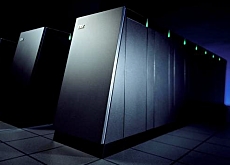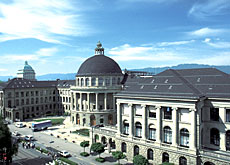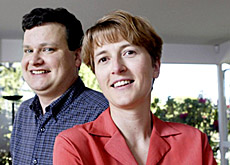Campus welcomes arrival of Blue Gene

Lausanne’s Federal Institute of Technology is hoping to boost its research by hosting one of the world’s fastest computers on its campus, IBM’s Blue Gene.
The supercomputer will be used primarily to penetrate the mysteries of the brain, but plenty of other researchers are lining up to make use of the prototype.
Blue Gene is currently the most powerful supercomputer available. According to specialists, its original modular design allows it to overcome the shortcomings of some of its competitors, making it the fastest type of machine around.
“Our first aim was to provide an enormous advantage to the campus, especially the teams working on numerical simulations,” said François Avellan, head of the institute’s steering committee, which is overseeing the project.
The system that will be installed at the institute will occupy the floor space equivalent to four refrigerators. Its top processing speed should reach at least 22.8 trillion mathematical operations per second, making it one of the speediest computers in Europe.
The best system anywhere is another Blue Gene prototype that ran nearly nine times faster in March in the United States. The average home computer can carry out about one billion operations per second.
Collaboration
According to Avellan, the project was mainly driven by the desire to set up a collaboration with IBM in the field of the life sciences. “IBM came to us with their prototype and it was an opportunity for us to develop simulations,” he told swissinfo.
The Blue Brain project, as it’s called, will focus primarily on neuroscience. Scientists from the institute want to create a detailed model of the neocortex, the largest and most complex part of the mammal brain.
They hope to extend their work to the rest of the brain, something that has never been attempted before at the cellular level. They should also gain better understanding of processes such as thought, perception and memory, as well as some of the causes of psychiatric disorders.
“Modelling the brain at the cellular level is a massive undertaking because of the hundreds of thousands of parameters that need to be taken into account,” said Henry Markram, the professor heading up the neuroscience project.
“With certain simulations we anticipate that a full day’s worth of […] lab research could be done in a matter of seconds on Blue Gene.”
Around half of the supercomputer’s capacity will be set aside for brain research. The other half will be used for projects such as molecular simulations, fluid dynamics, plasma physics or reproducing internet.
Savings
Part of the research will also include collaborations with IBM researchers in Zurich on the development of semiconductor technology, one of the building blocks of today’s electronics.
This agreement with the computer manufacturer has financial benefits for the institute, although there is an element of risk.
“If we went out and bought a supercomputer, it would cost us a lot more,” admits Avellan. “Working with IBM and its prototype involves some difficulties, but we are convinced the institute can only benefit from this collaboration.”
The reference price for a single Blue Gene server is SFr10 million ($8 million), but the institute says the deal it cut with IBM means it will cost far less.
Whether the supercomputer will actually generate any savings for the school by performing more virtual experimentation is not clear.
“It’s hard to say if using Blue Gene will save us money,” said Avellan. “On the other hand, it will allow us to do things we never thought possible.”
swissinfo, Scott Capper
When it was launched in 1999, IBM’s Blue Gene project aimed to develop a computer system for the study of complex biomolecular phenomena such as protein folding.
Today, Blue Gene can run applications for life sciences, financial modelling, hydrodynamics, quantum chemistry, molecular dynamics, astronomy and space research and climate modelling.
Blue Gene systems are installed at Lawrence Livermore National Laboratory, San Diego Supercomputing Center, and Argonne National Laboratory in the United States as well as Edinburgh University.

In compliance with the JTI standards
More: SWI swissinfo.ch certified by the Journalism Trust Initiative


You can find an overview of ongoing debates with our journalists here. Please join us!
If you want to start a conversation about a topic raised in this article or want to report factual errors, email us at english@swissinfo.ch.